Coles Supermarket: Strategic Analysis, Industry, and Internal Factors
VerifiedAdded on 2023/06/10
|13
|2967
|114
Case Study
AI Summary
This case study provides a comprehensive strategic analysis of Coles Supermarkets Australia Pty Ltd, examining its external and internal environments, industry position, and business-level strategies. The analysis begins with a PESTEL analysis, highlighting the political, economic, social, technological, legal, and environmental factors impacting Coles. It then delves into an industry analysis using Porter's Five Forces to assess the competitive landscape. The internal analysis identifies Coles' key resources, core competencies, strengths, and weaknesses. Finally, the case study evaluates the business-level strategies implemented by Coles, including its 'Australia first' sourcing policy and value chain activities, to determine their effectiveness in achieving a competitive advantage and sustainable profitability. This document is available on Desklib, a platform offering a wide range of study tools and solved assignments for students.
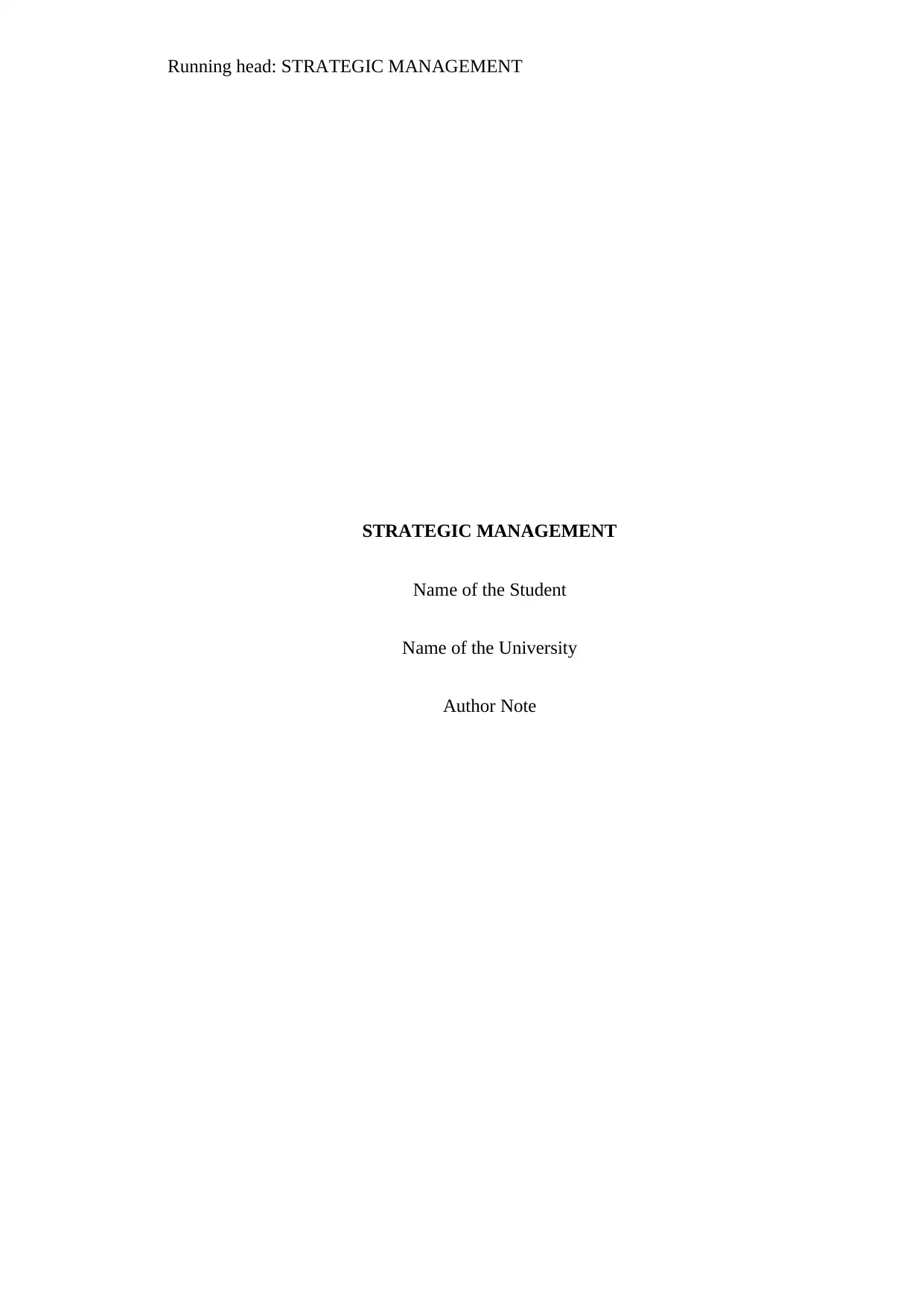
Running head: STRATEGIC MANAGEMENT
STRATEGIC MANAGEMENT
Name of the Student
Name of the University
Author Note
STRATEGIC MANAGEMENT
Name of the Student
Name of the University
Author Note
Paraphrase This Document
Need a fresh take? Get an instant paraphrase of this document with our AI Paraphraser
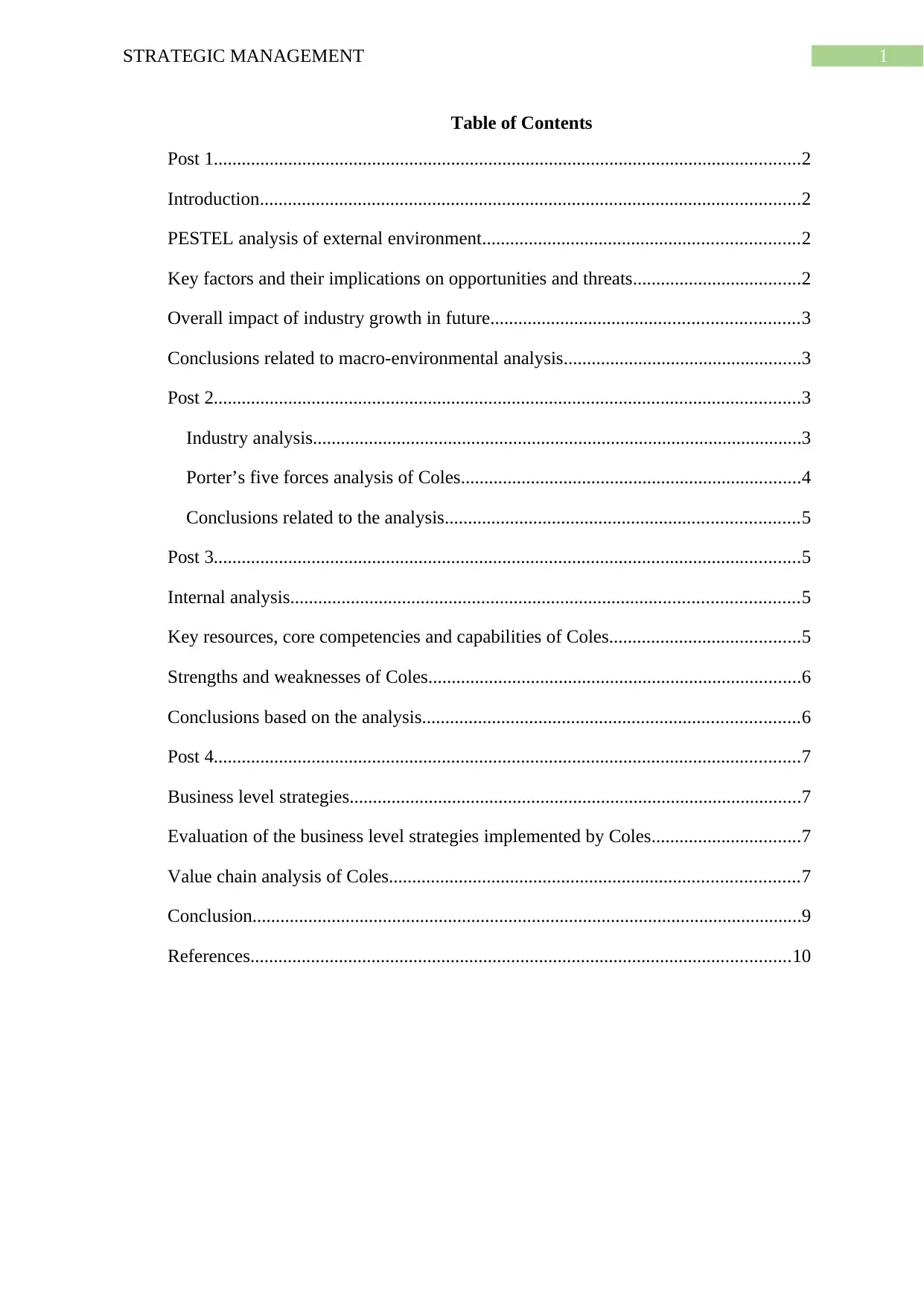
1STRATEGIC MANAGEMENT
Table of Contents
Post 1..............................................................................................................................2
Introduction....................................................................................................................2
PESTEL analysis of external environment....................................................................2
Key factors and their implications on opportunities and threats....................................2
Overall impact of industry growth in future..................................................................3
Conclusions related to macro-environmental analysis...................................................3
Post 2..............................................................................................................................3
Industry analysis.........................................................................................................3
Porter’s five forces analysis of Coles.........................................................................4
Conclusions related to the analysis............................................................................5
Post 3..............................................................................................................................5
Internal analysis.............................................................................................................5
Key resources, core competencies and capabilities of Coles.........................................5
Strengths and weaknesses of Coles................................................................................6
Conclusions based on the analysis.................................................................................6
Post 4..............................................................................................................................7
Business level strategies.................................................................................................7
Evaluation of the business level strategies implemented by Coles................................7
Value chain analysis of Coles........................................................................................7
Conclusion......................................................................................................................9
References....................................................................................................................10
Table of Contents
Post 1..............................................................................................................................2
Introduction....................................................................................................................2
PESTEL analysis of external environment....................................................................2
Key factors and their implications on opportunities and threats....................................2
Overall impact of industry growth in future..................................................................3
Conclusions related to macro-environmental analysis...................................................3
Post 2..............................................................................................................................3
Industry analysis.........................................................................................................3
Porter’s five forces analysis of Coles.........................................................................4
Conclusions related to the analysis............................................................................5
Post 3..............................................................................................................................5
Internal analysis.............................................................................................................5
Key resources, core competencies and capabilities of Coles.........................................5
Strengths and weaknesses of Coles................................................................................6
Conclusions based on the analysis.................................................................................6
Post 4..............................................................................................................................7
Business level strategies.................................................................................................7
Evaluation of the business level strategies implemented by Coles................................7
Value chain analysis of Coles........................................................................................7
Conclusion......................................................................................................................9
References....................................................................................................................10
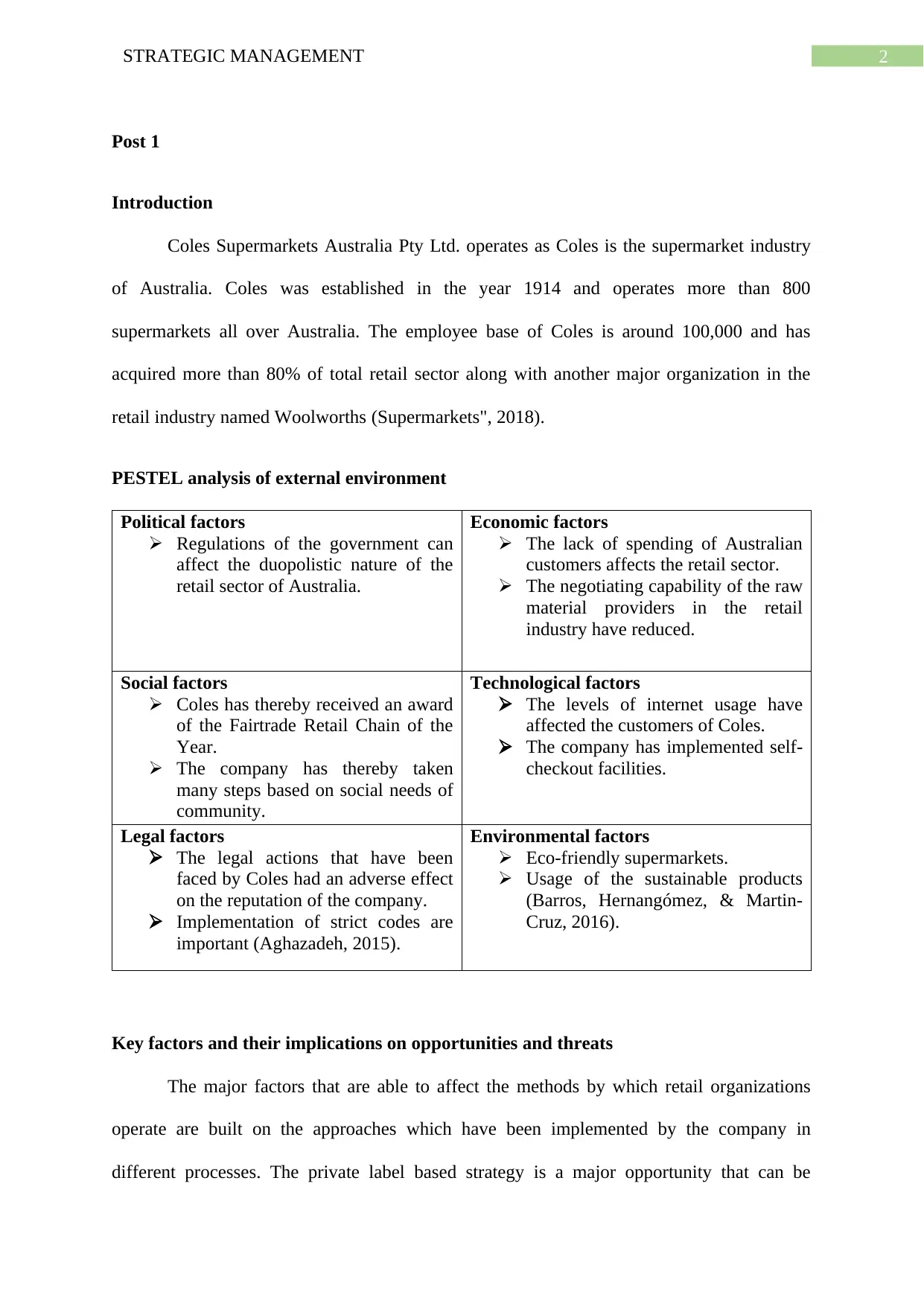
2STRATEGIC MANAGEMENT
Post 1
Introduction
Coles Supermarkets Australia Pty Ltd. operates as Coles is the supermarket industry
of Australia. Coles was established in the year 1914 and operates more than 800
supermarkets all over Australia. The employee base of Coles is around 100,000 and has
acquired more than 80% of total retail sector along with another major organization in the
retail industry named Woolworths (Supermarkets", 2018).
PESTEL analysis of external environment
Political factors
Regulations of the government can
affect the duopolistic nature of the
retail sector of Australia.
Economic factors
The lack of spending of Australian
customers affects the retail sector.
The negotiating capability of the raw
material providers in the retail
industry have reduced.
Social factors
Coles has thereby received an award
of the Fairtrade Retail Chain of the
Year.
The company has thereby taken
many steps based on social needs of
community.
Technological factors
The levels of internet usage have
affected the customers of Coles.
The company has implemented self-
checkout facilities.
Legal factors
The legal actions that have been
faced by Coles had an adverse effect
on the reputation of the company.
Implementation of strict codes are
important (Aghazadeh, 2015).
Environmental factors
Eco-friendly supermarkets.
Usage of the sustainable products
(Barros, Hernangómez, & Martin-
Cruz, 2016).
Key factors and their implications on opportunities and threats
The major factors that are able to affect the methods by which retail organizations
operate are built on the approaches which have been implemented by the company in
different processes. The private label based strategy is a major opportunity that can be
Post 1
Introduction
Coles Supermarkets Australia Pty Ltd. operates as Coles is the supermarket industry
of Australia. Coles was established in the year 1914 and operates more than 800
supermarkets all over Australia. The employee base of Coles is around 100,000 and has
acquired more than 80% of total retail sector along with another major organization in the
retail industry named Woolworths (Supermarkets", 2018).
PESTEL analysis of external environment
Political factors
Regulations of the government can
affect the duopolistic nature of the
retail sector of Australia.
Economic factors
The lack of spending of Australian
customers affects the retail sector.
The negotiating capability of the raw
material providers in the retail
industry have reduced.
Social factors
Coles has thereby received an award
of the Fairtrade Retail Chain of the
Year.
The company has thereby taken
many steps based on social needs of
community.
Technological factors
The levels of internet usage have
affected the customers of Coles.
The company has implemented self-
checkout facilities.
Legal factors
The legal actions that have been
faced by Coles had an adverse effect
on the reputation of the company.
Implementation of strict codes are
important (Aghazadeh, 2015).
Environmental factors
Eco-friendly supermarkets.
Usage of the sustainable products
(Barros, Hernangómez, & Martin-
Cruz, 2016).
Key factors and their implications on opportunities and threats
The major factors that are able to affect the methods by which retail organizations
operate are built on the approaches which have been implemented by the company in
different processes. The private label based strategy is a major opportunity that can be
⊘ This is a preview!⊘
Do you want full access?
Subscribe today to unlock all pages.

Trusted by 1+ million students worldwide
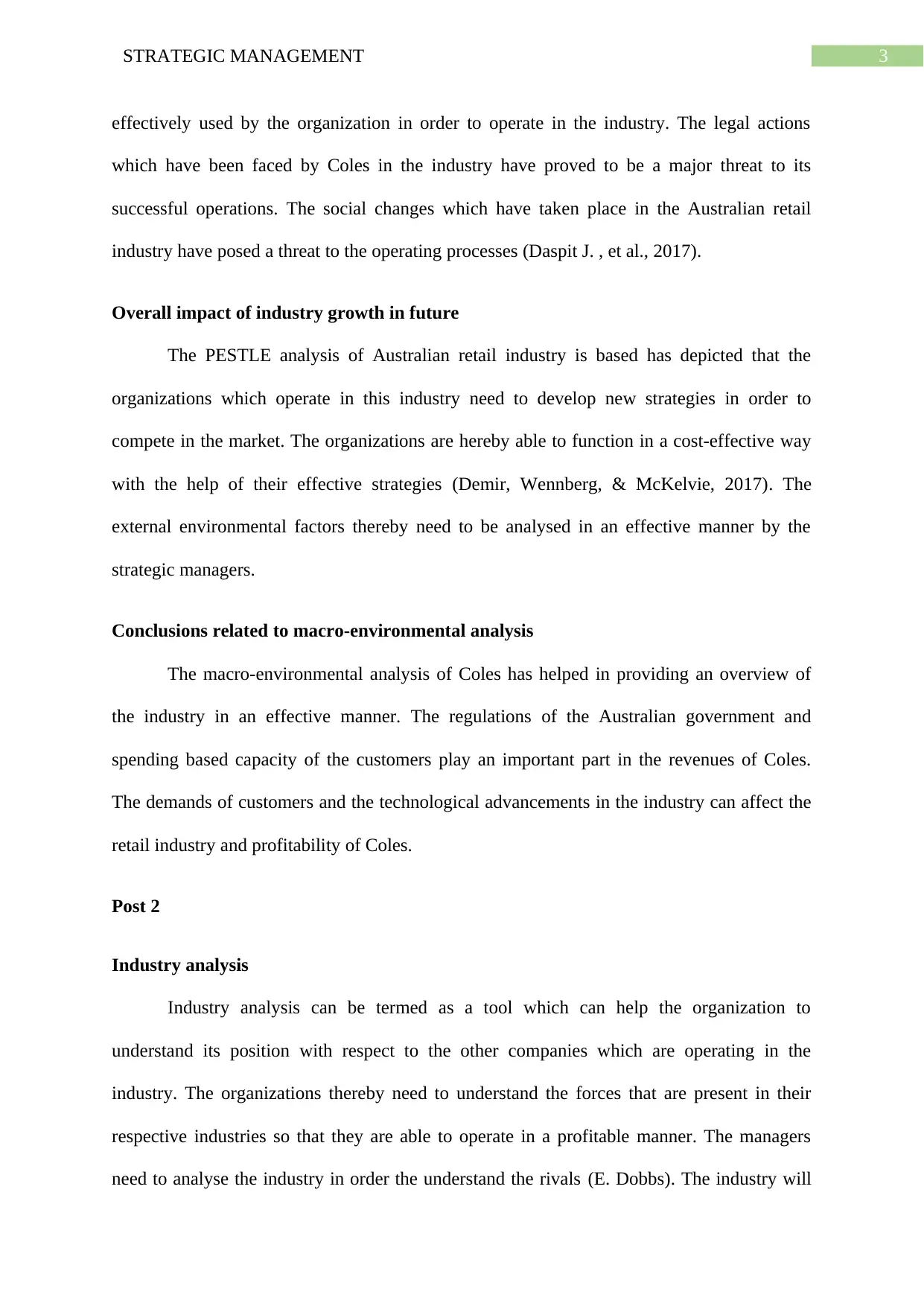
3STRATEGIC MANAGEMENT
effectively used by the organization in order to operate in the industry. The legal actions
which have been faced by Coles in the industry have proved to be a major threat to its
successful operations. The social changes which have taken place in the Australian retail
industry have posed a threat to the operating processes (Daspit J. , et al., 2017).
Overall impact of industry growth in future
The PESTLE analysis of Australian retail industry is based has depicted that the
organizations which operate in this industry need to develop new strategies in order to
compete in the market. The organizations are hereby able to function in a cost-effective way
with the help of their effective strategies (Demir, Wennberg, & McKelvie, 2017). The
external environmental factors thereby need to be analysed in an effective manner by the
strategic managers.
Conclusions related to macro-environmental analysis
The macro-environmental analysis of Coles has helped in providing an overview of
the industry in an effective manner. The regulations of the Australian government and
spending based capacity of the customers play an important part in the revenues of Coles.
The demands of customers and the technological advancements in the industry can affect the
retail industry and profitability of Coles.
Post 2
Industry analysis
Industry analysis can be termed as a tool which can help the organization to
understand its position with respect to the other companies which are operating in the
industry. The organizations thereby need to understand the forces that are present in their
respective industries so that they are able to operate in a profitable manner. The managers
need to analyse the industry in order the understand the rivals (E. Dobbs). The industry will
effectively used by the organization in order to operate in the industry. The legal actions
which have been faced by Coles in the industry have proved to be a major threat to its
successful operations. The social changes which have taken place in the Australian retail
industry have posed a threat to the operating processes (Daspit J. , et al., 2017).
Overall impact of industry growth in future
The PESTLE analysis of Australian retail industry is based has depicted that the
organizations which operate in this industry need to develop new strategies in order to
compete in the market. The organizations are hereby able to function in a cost-effective way
with the help of their effective strategies (Demir, Wennberg, & McKelvie, 2017). The
external environmental factors thereby need to be analysed in an effective manner by the
strategic managers.
Conclusions related to macro-environmental analysis
The macro-environmental analysis of Coles has helped in providing an overview of
the industry in an effective manner. The regulations of the Australian government and
spending based capacity of the customers play an important part in the revenues of Coles.
The demands of customers and the technological advancements in the industry can affect the
retail industry and profitability of Coles.
Post 2
Industry analysis
Industry analysis can be termed as a tool which can help the organization to
understand its position with respect to the other companies which are operating in the
industry. The organizations thereby need to understand the forces that are present in their
respective industries so that they are able to operate in a profitable manner. The managers
need to analyse the industry in order the understand the rivals (E. Dobbs). The industry will
Paraphrase This Document
Need a fresh take? Get an instant paraphrase of this document with our AI Paraphraser
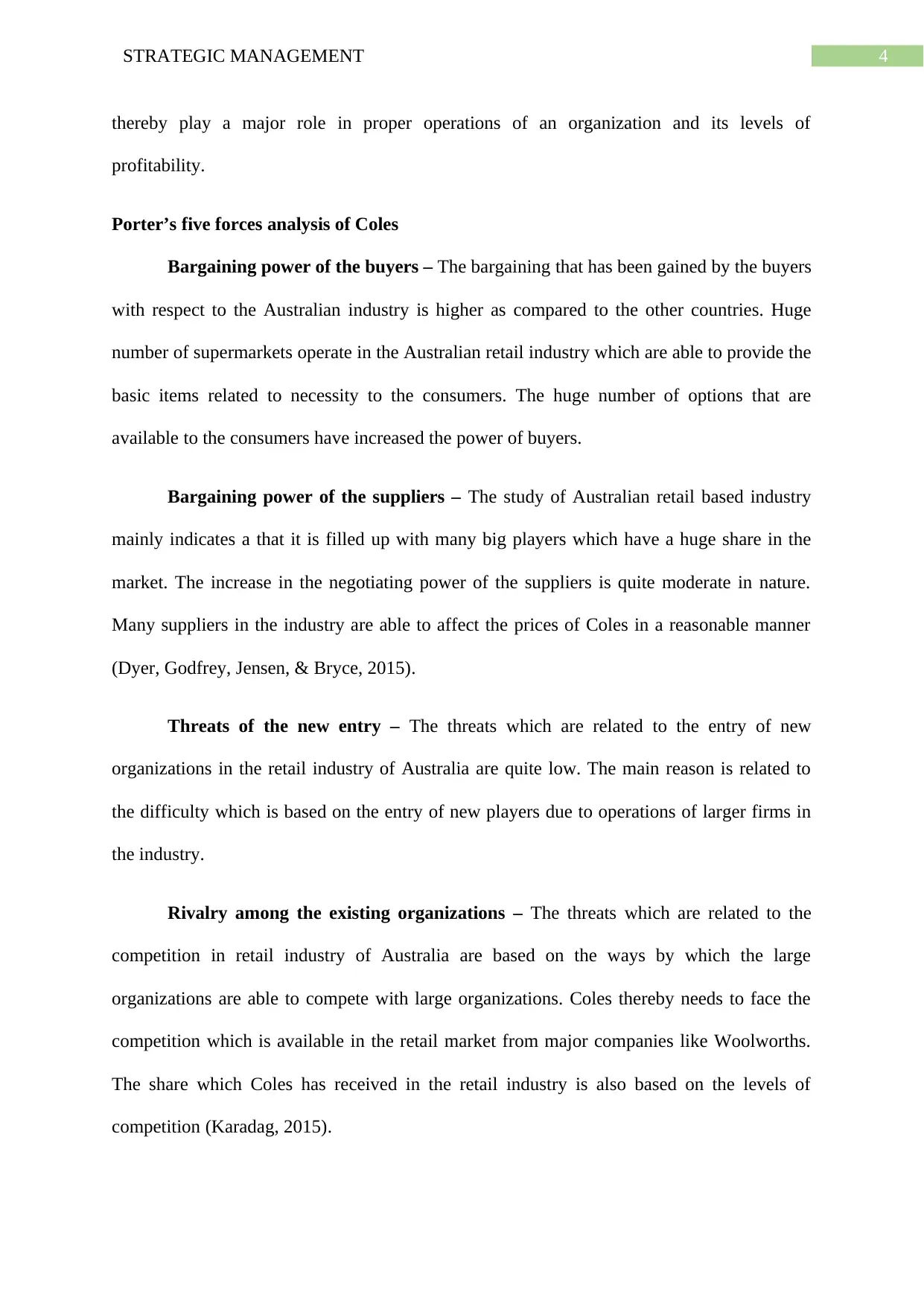
4STRATEGIC MANAGEMENT
thereby play a major role in proper operations of an organization and its levels of
profitability.
Porter’s five forces analysis of Coles
Bargaining power of the buyers – The bargaining that has been gained by the buyers
with respect to the Australian industry is higher as compared to the other countries. Huge
number of supermarkets operate in the Australian retail industry which are able to provide the
basic items related to necessity to the consumers. The huge number of options that are
available to the consumers have increased the power of buyers.
Bargaining power of the suppliers – The study of Australian retail based industry
mainly indicates a that it is filled up with many big players which have a huge share in the
market. The increase in the negotiating power of the suppliers is quite moderate in nature.
Many suppliers in the industry are able to affect the prices of Coles in a reasonable manner
(Dyer, Godfrey, Jensen, & Bryce, 2015).
Threats of the new entry – The threats which are related to the entry of new
organizations in the retail industry of Australia are quite low. The main reason is related to
the difficulty which is based on the entry of new players due to operations of larger firms in
the industry.
Rivalry among the existing organizations – The threats which are related to the
competition in retail industry of Australia are based on the ways by which the large
organizations are able to compete with large organizations. Coles thereby needs to face the
competition which is available in the retail market from major companies like Woolworths.
The share which Coles has received in the retail industry is also based on the levels of
competition (Karadag, 2015).
thereby play a major role in proper operations of an organization and its levels of
profitability.
Porter’s five forces analysis of Coles
Bargaining power of the buyers – The bargaining that has been gained by the buyers
with respect to the Australian industry is higher as compared to the other countries. Huge
number of supermarkets operate in the Australian retail industry which are able to provide the
basic items related to necessity to the consumers. The huge number of options that are
available to the consumers have increased the power of buyers.
Bargaining power of the suppliers – The study of Australian retail based industry
mainly indicates a that it is filled up with many big players which have a huge share in the
market. The increase in the negotiating power of the suppliers is quite moderate in nature.
Many suppliers in the industry are able to affect the prices of Coles in a reasonable manner
(Dyer, Godfrey, Jensen, & Bryce, 2015).
Threats of the new entry – The threats which are related to the entry of new
organizations in the retail industry of Australia are quite low. The main reason is related to
the difficulty which is based on the entry of new players due to operations of larger firms in
the industry.
Rivalry among the existing organizations – The threats which are related to the
competition in retail industry of Australia are based on the ways by which the large
organizations are able to compete with large organizations. Coles thereby needs to face the
competition which is available in the retail market from major companies like Woolworths.
The share which Coles has received in the retail industry is also based on the levels of
competition (Karadag, 2015).
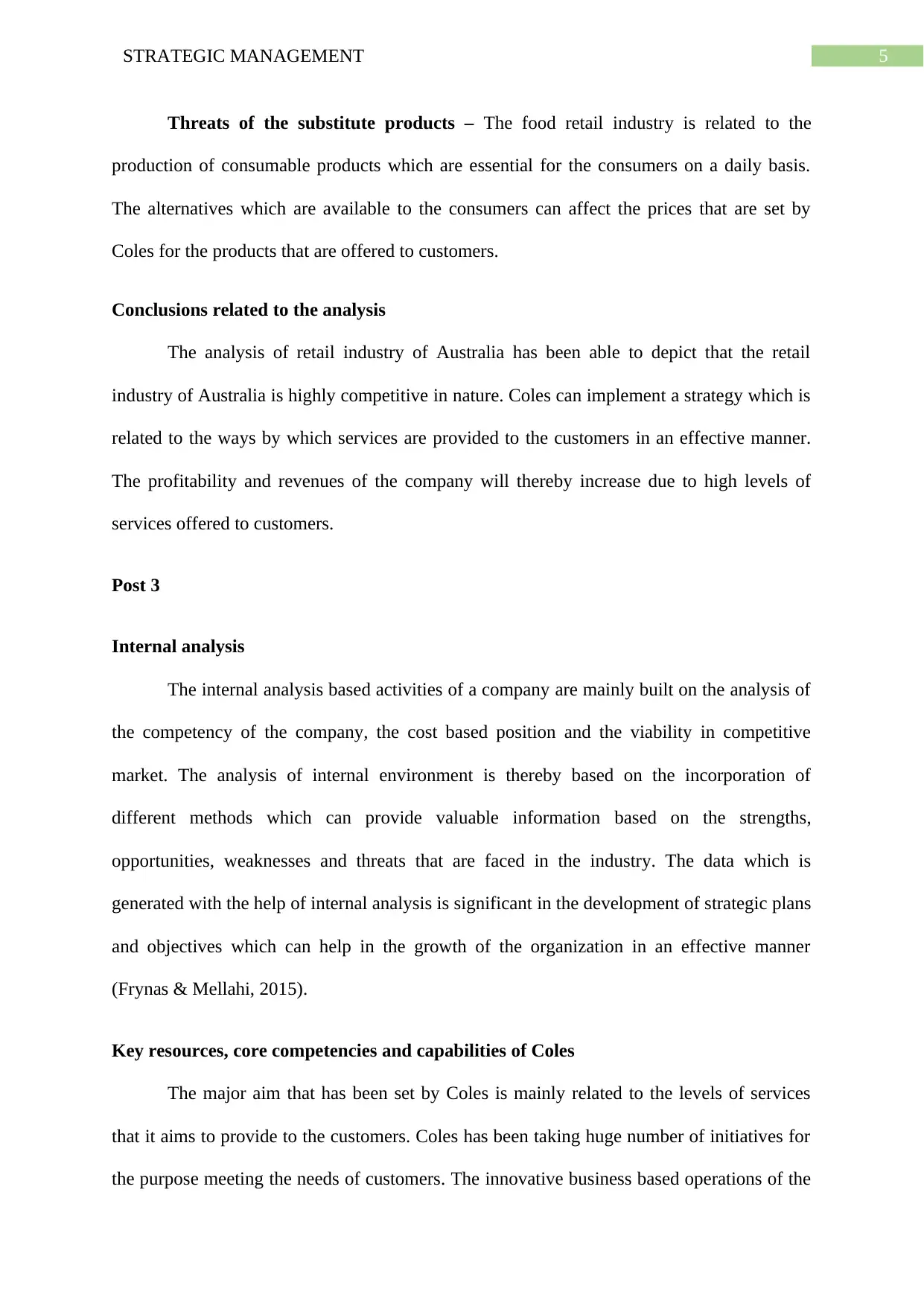
5STRATEGIC MANAGEMENT
Threats of the substitute products – The food retail industry is related to the
production of consumable products which are essential for the consumers on a daily basis.
The alternatives which are available to the consumers can affect the prices that are set by
Coles for the products that are offered to customers.
Conclusions related to the analysis
The analysis of retail industry of Australia has been able to depict that the retail
industry of Australia is highly competitive in nature. Coles can implement a strategy which is
related to the ways by which services are provided to the customers in an effective manner.
The profitability and revenues of the company will thereby increase due to high levels of
services offered to customers.
Post 3
Internal analysis
The internal analysis based activities of a company are mainly built on the analysis of
the competency of the company, the cost based position and the viability in competitive
market. The analysis of internal environment is thereby based on the incorporation of
different methods which can provide valuable information based on the strengths,
opportunities, weaknesses and threats that are faced in the industry. The data which is
generated with the help of internal analysis is significant in the development of strategic plans
and objectives which can help in the growth of the organization in an effective manner
(Frynas & Mellahi, 2015).
Key resources, core competencies and capabilities of Coles
The major aim that has been set by Coles is mainly related to the levels of services
that it aims to provide to the customers. Coles has been taking huge number of initiatives for
the purpose meeting the needs of customers. The innovative business based operations of the
Threats of the substitute products – The food retail industry is related to the
production of consumable products which are essential for the consumers on a daily basis.
The alternatives which are available to the consumers can affect the prices that are set by
Coles for the products that are offered to customers.
Conclusions related to the analysis
The analysis of retail industry of Australia has been able to depict that the retail
industry of Australia is highly competitive in nature. Coles can implement a strategy which is
related to the ways by which services are provided to the customers in an effective manner.
The profitability and revenues of the company will thereby increase due to high levels of
services offered to customers.
Post 3
Internal analysis
The internal analysis based activities of a company are mainly built on the analysis of
the competency of the company, the cost based position and the viability in competitive
market. The analysis of internal environment is thereby based on the incorporation of
different methods which can provide valuable information based on the strengths,
opportunities, weaknesses and threats that are faced in the industry. The data which is
generated with the help of internal analysis is significant in the development of strategic plans
and objectives which can help in the growth of the organization in an effective manner
(Frynas & Mellahi, 2015).
Key resources, core competencies and capabilities of Coles
The major aim that has been set by Coles is mainly related to the levels of services
that it aims to provide to the customers. Coles has been taking huge number of initiatives for
the purpose meeting the needs of customers. The innovative business based operations of the
⊘ This is a preview!⊘
Do you want full access?
Subscribe today to unlock all pages.

Trusted by 1+ million students worldwide
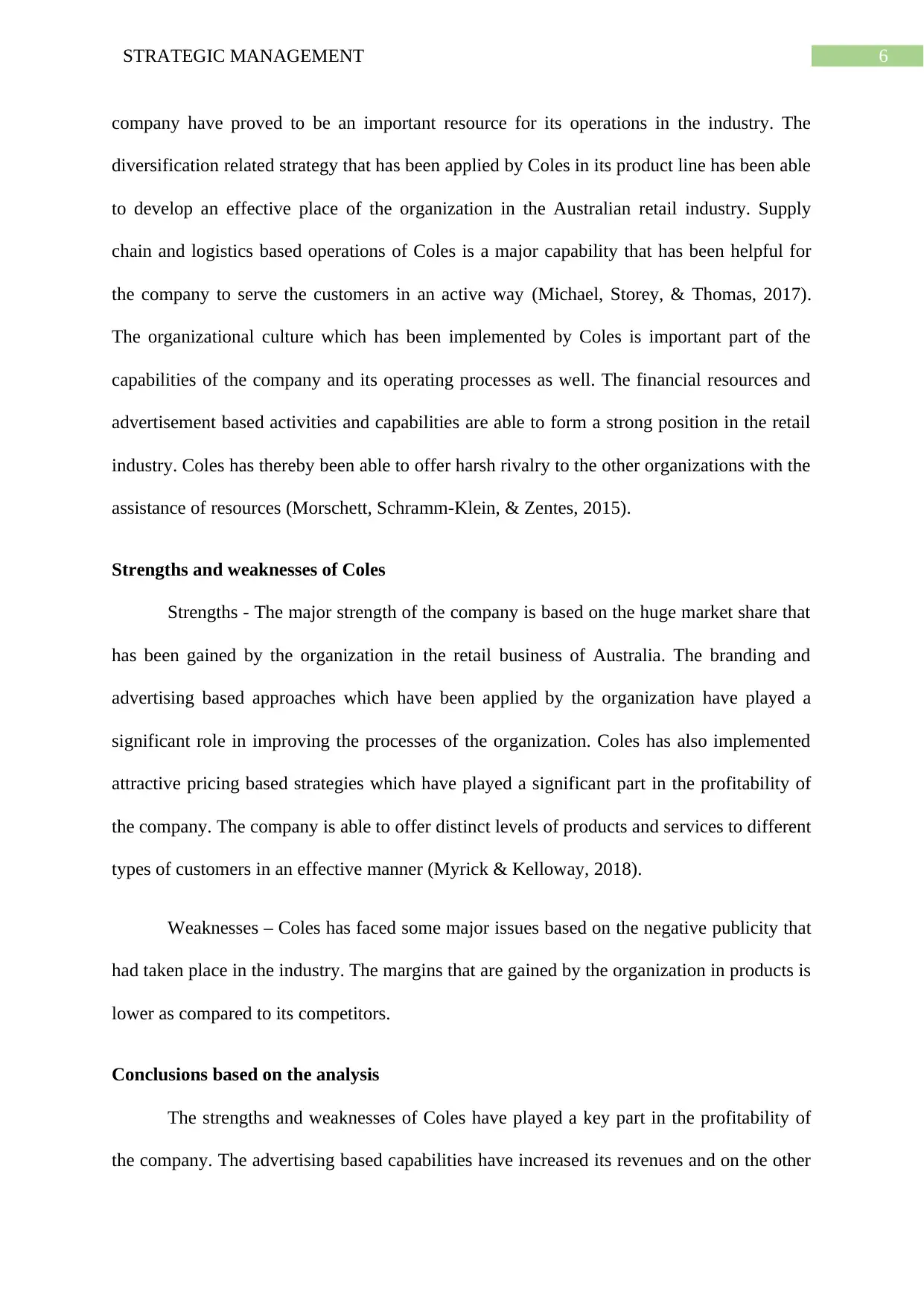
6STRATEGIC MANAGEMENT
company have proved to be an important resource for its operations in the industry. The
diversification related strategy that has been applied by Coles in its product line has been able
to develop an effective place of the organization in the Australian retail industry. Supply
chain and logistics based operations of Coles is a major capability that has been helpful for
the company to serve the customers in an active way (Michael, Storey, & Thomas, 2017).
The organizational culture which has been implemented by Coles is important part of the
capabilities of the company and its operating processes as well. The financial resources and
advertisement based activities and capabilities are able to form a strong position in the retail
industry. Coles has thereby been able to offer harsh rivalry to the other organizations with the
assistance of resources (Morschett, Schramm-Klein, & Zentes, 2015).
Strengths and weaknesses of Coles
Strengths - The major strength of the company is based on the huge market share that
has been gained by the organization in the retail business of Australia. The branding and
advertising based approaches which have been applied by the organization have played a
significant role in improving the processes of the organization. Coles has also implemented
attractive pricing based strategies which have played a significant part in the profitability of
the company. The company is able to offer distinct levels of products and services to different
types of customers in an effective manner (Myrick & Kelloway, 2018).
Weaknesses – Coles has faced some major issues based on the negative publicity that
had taken place in the industry. The margins that are gained by the organization in products is
lower as compared to its competitors.
Conclusions based on the analysis
The strengths and weaknesses of Coles have played a key part in the profitability of
the company. The advertising based capabilities have increased its revenues and on the other
company have proved to be an important resource for its operations in the industry. The
diversification related strategy that has been applied by Coles in its product line has been able
to develop an effective place of the organization in the Australian retail industry. Supply
chain and logistics based operations of Coles is a major capability that has been helpful for
the company to serve the customers in an active way (Michael, Storey, & Thomas, 2017).
The organizational culture which has been implemented by Coles is important part of the
capabilities of the company and its operating processes as well. The financial resources and
advertisement based activities and capabilities are able to form a strong position in the retail
industry. Coles has thereby been able to offer harsh rivalry to the other organizations with the
assistance of resources (Morschett, Schramm-Klein, & Zentes, 2015).
Strengths and weaknesses of Coles
Strengths - The major strength of the company is based on the huge market share that
has been gained by the organization in the retail business of Australia. The branding and
advertising based approaches which have been applied by the organization have played a
significant role in improving the processes of the organization. Coles has also implemented
attractive pricing based strategies which have played a significant part in the profitability of
the company. The company is able to offer distinct levels of products and services to different
types of customers in an effective manner (Myrick & Kelloway, 2018).
Weaknesses – Coles has faced some major issues based on the negative publicity that
had taken place in the industry. The margins that are gained by the organization in products is
lower as compared to its competitors.
Conclusions based on the analysis
The strengths and weaknesses of Coles have played a key part in the profitability of
the company. The advertising based capabilities have increased its revenues and on the other
Paraphrase This Document
Need a fresh take? Get an instant paraphrase of this document with our AI Paraphraser
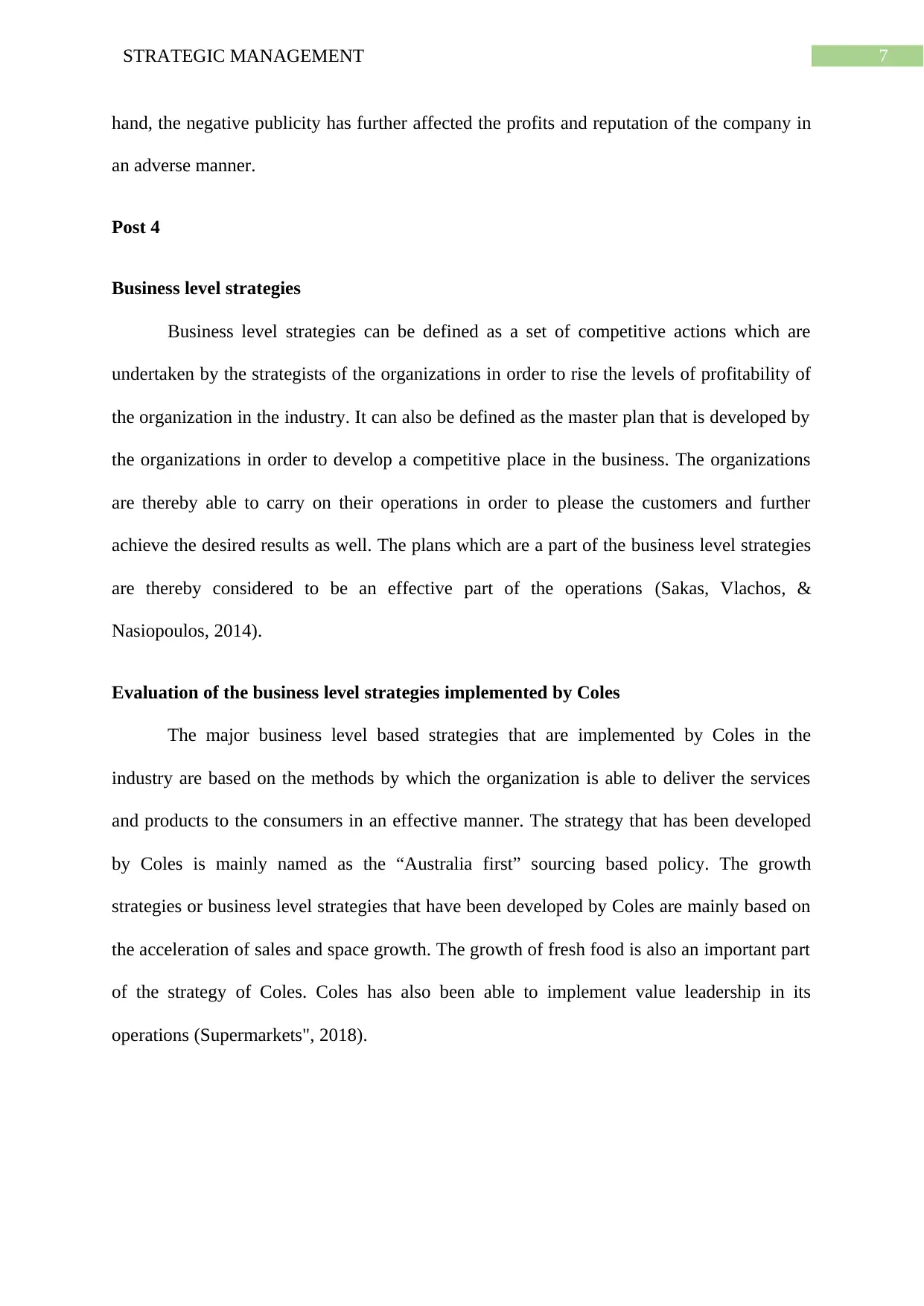
7STRATEGIC MANAGEMENT
hand, the negative publicity has further affected the profits and reputation of the company in
an adverse manner.
Post 4
Business level strategies
Business level strategies can be defined as a set of competitive actions which are
undertaken by the strategists of the organizations in order to rise the levels of profitability of
the organization in the industry. It can also be defined as the master plan that is developed by
the organizations in order to develop a competitive place in the business. The organizations
are thereby able to carry on their operations in order to please the customers and further
achieve the desired results as well. The plans which are a part of the business level strategies
are thereby considered to be an effective part of the operations (Sakas, Vlachos, &
Nasiopoulos, 2014).
Evaluation of the business level strategies implemented by Coles
The major business level based strategies that are implemented by Coles in the
industry are based on the methods by which the organization is able to deliver the services
and products to the consumers in an effective manner. The strategy that has been developed
by Coles is mainly named as the “Australia first” sourcing based policy. The growth
strategies or business level strategies that have been developed by Coles are mainly based on
the acceleration of sales and space growth. The growth of fresh food is also an important part
of the strategy of Coles. Coles has also been able to implement value leadership in its
operations (Supermarkets", 2018).
hand, the negative publicity has further affected the profits and reputation of the company in
an adverse manner.
Post 4
Business level strategies
Business level strategies can be defined as a set of competitive actions which are
undertaken by the strategists of the organizations in order to rise the levels of profitability of
the organization in the industry. It can also be defined as the master plan that is developed by
the organizations in order to develop a competitive place in the business. The organizations
are thereby able to carry on their operations in order to please the customers and further
achieve the desired results as well. The plans which are a part of the business level strategies
are thereby considered to be an effective part of the operations (Sakas, Vlachos, &
Nasiopoulos, 2014).
Evaluation of the business level strategies implemented by Coles
The major business level based strategies that are implemented by Coles in the
industry are based on the methods by which the organization is able to deliver the services
and products to the consumers in an effective manner. The strategy that has been developed
by Coles is mainly named as the “Australia first” sourcing based policy. The growth
strategies or business level strategies that have been developed by Coles are mainly based on
the acceleration of sales and space growth. The growth of fresh food is also an important part
of the strategy of Coles. Coles has also been able to implement value leadership in its
operations (Supermarkets", 2018).
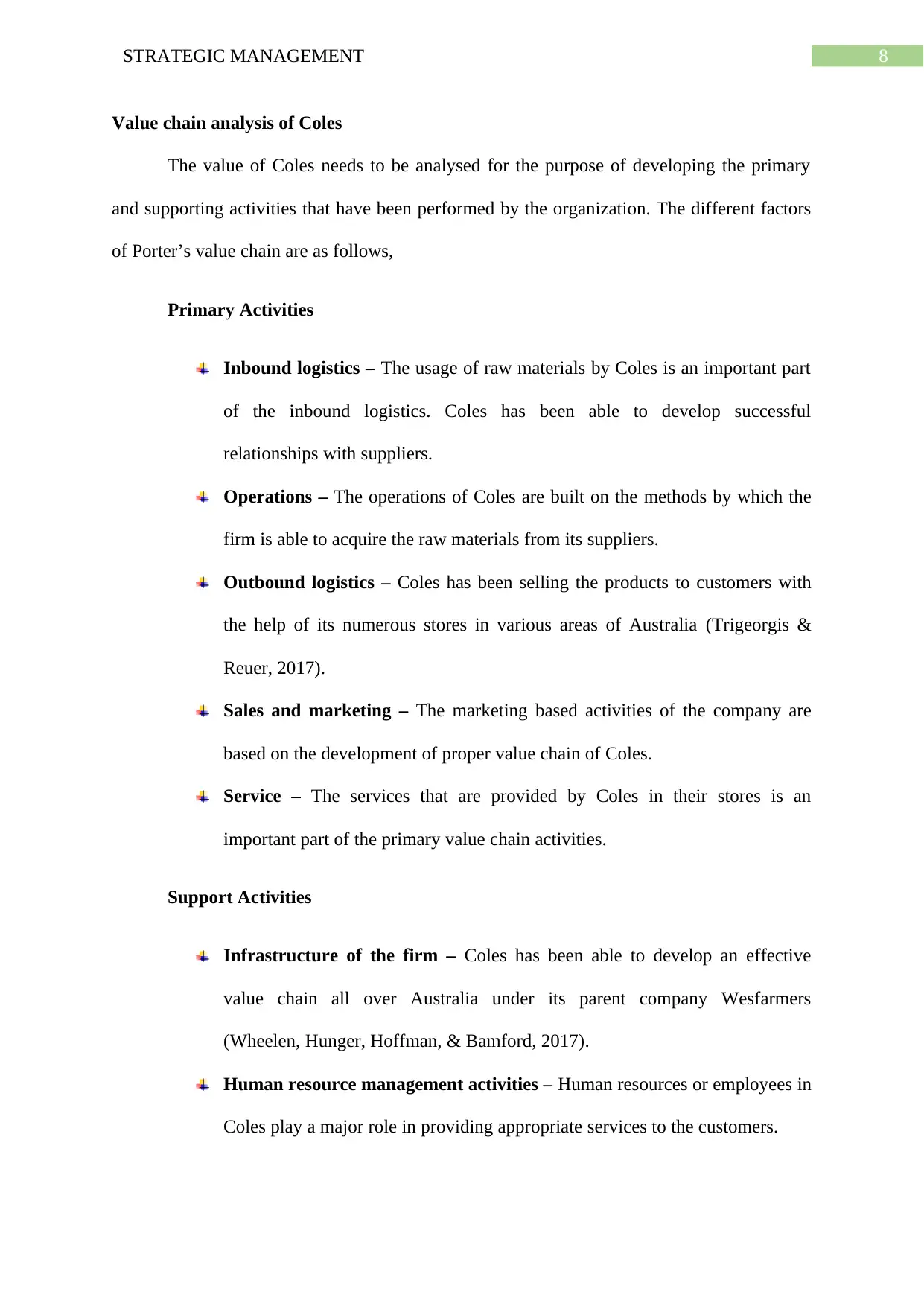
8STRATEGIC MANAGEMENT
Value chain analysis of Coles
The value of Coles needs to be analysed for the purpose of developing the primary
and supporting activities that have been performed by the organization. The different factors
of Porter’s value chain are as follows,
Primary Activities
Inbound logistics – The usage of raw materials by Coles is an important part
of the inbound logistics. Coles has been able to develop successful
relationships with suppliers.
Operations – The operations of Coles are built on the methods by which the
firm is able to acquire the raw materials from its suppliers.
Outbound logistics – Coles has been selling the products to customers with
the help of its numerous stores in various areas of Australia (Trigeorgis &
Reuer, 2017).
Sales and marketing – The marketing based activities of the company are
based on the development of proper value chain of Coles.
Service – The services that are provided by Coles in their stores is an
important part of the primary value chain activities.
Support Activities
Infrastructure of the firm – Coles has been able to develop an effective
value chain all over Australia under its parent company Wesfarmers
(Wheelen, Hunger, Hoffman, & Bamford, 2017).
Human resource management activities – Human resources or employees in
Coles play a major role in providing appropriate services to the customers.
Value chain analysis of Coles
The value of Coles needs to be analysed for the purpose of developing the primary
and supporting activities that have been performed by the organization. The different factors
of Porter’s value chain are as follows,
Primary Activities
Inbound logistics – The usage of raw materials by Coles is an important part
of the inbound logistics. Coles has been able to develop successful
relationships with suppliers.
Operations – The operations of Coles are built on the methods by which the
firm is able to acquire the raw materials from its suppliers.
Outbound logistics – Coles has been selling the products to customers with
the help of its numerous stores in various areas of Australia (Trigeorgis &
Reuer, 2017).
Sales and marketing – The marketing based activities of the company are
based on the development of proper value chain of Coles.
Service – The services that are provided by Coles in their stores is an
important part of the primary value chain activities.
Support Activities
Infrastructure of the firm – Coles has been able to develop an effective
value chain all over Australia under its parent company Wesfarmers
(Wheelen, Hunger, Hoffman, & Bamford, 2017).
Human resource management activities – Human resources or employees in
Coles play a major role in providing appropriate services to the customers.
⊘ This is a preview!⊘
Do you want full access?
Subscribe today to unlock all pages.

Trusted by 1+ million students worldwide
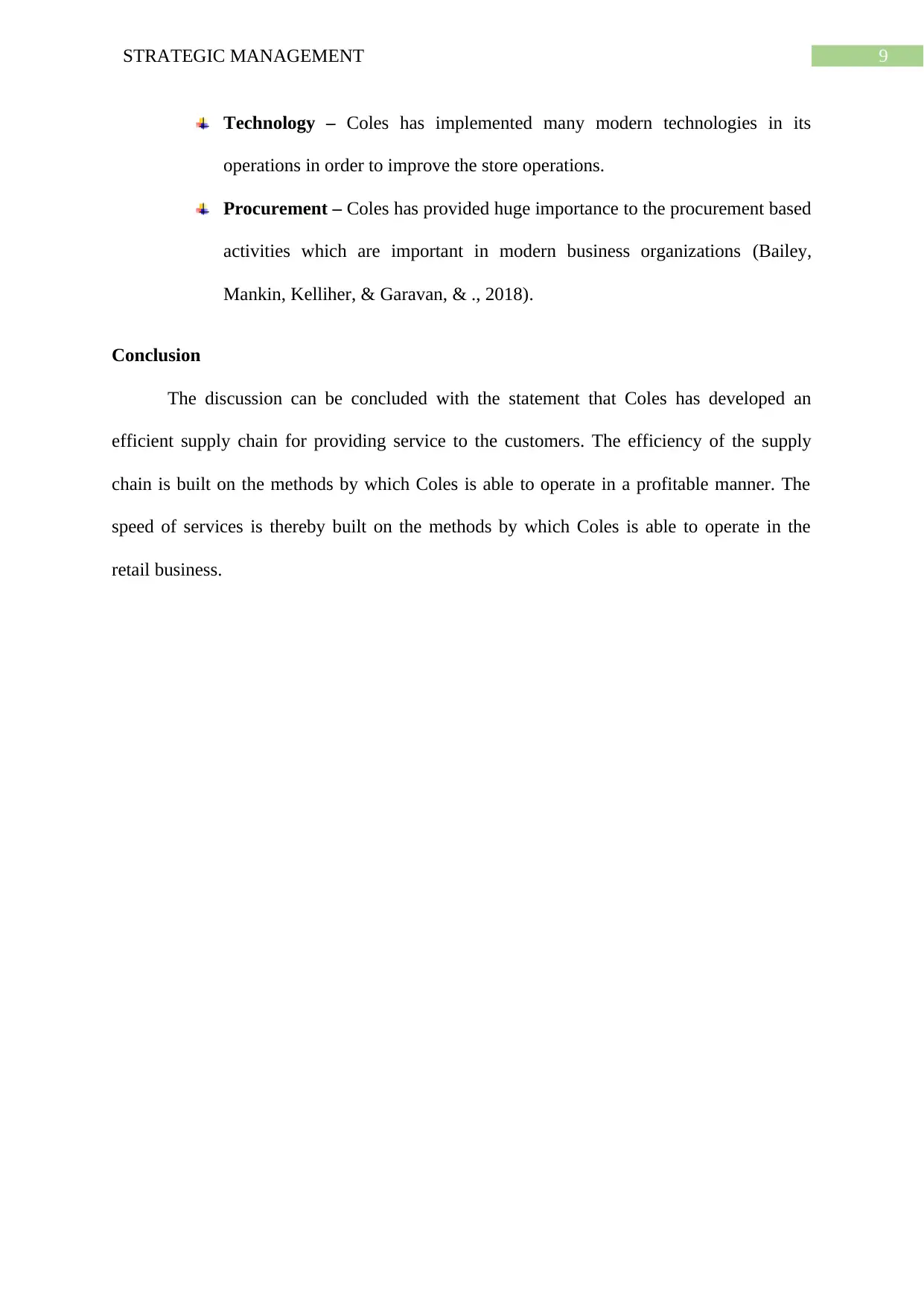
9STRATEGIC MANAGEMENT
Technology – Coles has implemented many modern technologies in its
operations in order to improve the store operations.
Procurement – Coles has provided huge importance to the procurement based
activities which are important in modern business organizations (Bailey,
Mankin, Kelliher, & Garavan, & ., 2018).
Conclusion
The discussion can be concluded with the statement that Coles has developed an
efficient supply chain for providing service to the customers. The efficiency of the supply
chain is built on the methods by which Coles is able to operate in a profitable manner. The
speed of services is thereby built on the methods by which Coles is able to operate in the
retail business.
Technology – Coles has implemented many modern technologies in its
operations in order to improve the store operations.
Procurement – Coles has provided huge importance to the procurement based
activities which are important in modern business organizations (Bailey,
Mankin, Kelliher, & Garavan, & ., 2018).
Conclusion
The discussion can be concluded with the statement that Coles has developed an
efficient supply chain for providing service to the customers. The efficiency of the supply
chain is built on the methods by which Coles is able to operate in a profitable manner. The
speed of services is thereby built on the methods by which Coles is able to operate in the
retail business.
Paraphrase This Document
Need a fresh take? Get an instant paraphrase of this document with our AI Paraphraser
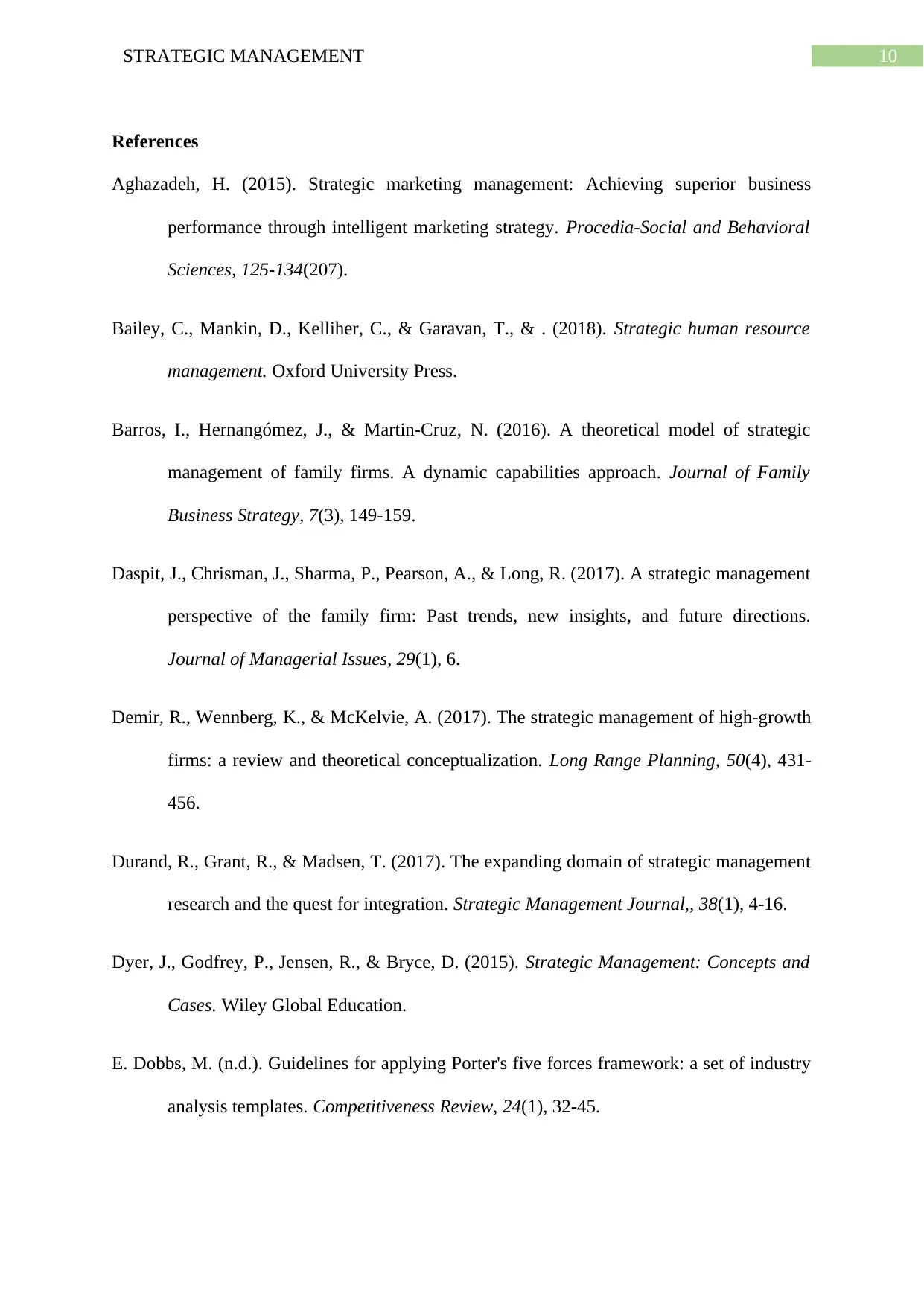
10STRATEGIC MANAGEMENT
References
Aghazadeh, H. (2015). Strategic marketing management: Achieving superior business
performance through intelligent marketing strategy. Procedia-Social and Behavioral
Sciences, 125-134(207).
Bailey, C., Mankin, D., Kelliher, C., & Garavan, T., & . (2018). Strategic human resource
management. Oxford University Press.
Barros, I., Hernangómez, J., & Martin-Cruz, N. (2016). A theoretical model of strategic
management of family firms. A dynamic capabilities approach. Journal of Family
Business Strategy, 7(3), 149-159.
Daspit, J., Chrisman, J., Sharma, P., Pearson, A., & Long, R. (2017). A strategic management
perspective of the family firm: Past trends, new insights, and future directions.
Journal of Managerial Issues, 29(1), 6.
Demir, R., Wennberg, K., & McKelvie, A. (2017). The strategic management of high-growth
firms: a review and theoretical conceptualization. Long Range Planning, 50(4), 431-
456.
Durand, R., Grant, R., & Madsen, T. (2017). The expanding domain of strategic management
research and the quest for integration. Strategic Management Journal,, 38(1), 4-16.
Dyer, J., Godfrey, P., Jensen, R., & Bryce, D. (2015). Strategic Management: Concepts and
Cases. Wiley Global Education.
E. Dobbs, M. (n.d.). Guidelines for applying Porter's five forces framework: a set of industry
analysis templates. Competitiveness Review, 24(1), 32-45.
References
Aghazadeh, H. (2015). Strategic marketing management: Achieving superior business
performance through intelligent marketing strategy. Procedia-Social and Behavioral
Sciences, 125-134(207).
Bailey, C., Mankin, D., Kelliher, C., & Garavan, T., & . (2018). Strategic human resource
management. Oxford University Press.
Barros, I., Hernangómez, J., & Martin-Cruz, N. (2016). A theoretical model of strategic
management of family firms. A dynamic capabilities approach. Journal of Family
Business Strategy, 7(3), 149-159.
Daspit, J., Chrisman, J., Sharma, P., Pearson, A., & Long, R. (2017). A strategic management
perspective of the family firm: Past trends, new insights, and future directions.
Journal of Managerial Issues, 29(1), 6.
Demir, R., Wennberg, K., & McKelvie, A. (2017). The strategic management of high-growth
firms: a review and theoretical conceptualization. Long Range Planning, 50(4), 431-
456.
Durand, R., Grant, R., & Madsen, T. (2017). The expanding domain of strategic management
research and the quest for integration. Strategic Management Journal,, 38(1), 4-16.
Dyer, J., Godfrey, P., Jensen, R., & Bryce, D. (2015). Strategic Management: Concepts and
Cases. Wiley Global Education.
E. Dobbs, M. (n.d.). Guidelines for applying Porter's five forces framework: a set of industry
analysis templates. Competitiveness Review, 24(1), 32-45.
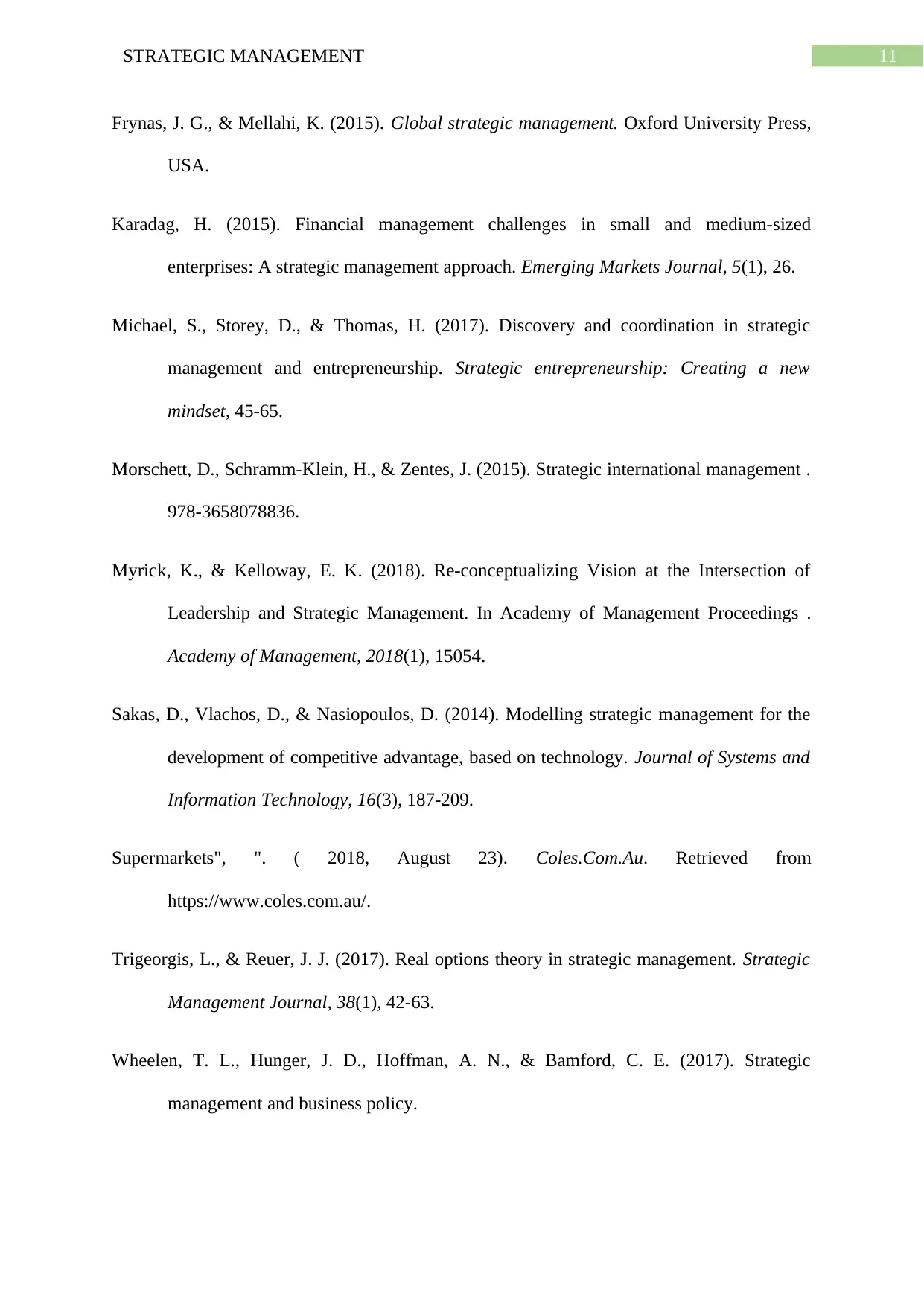
11STRATEGIC MANAGEMENT
Frynas, J. G., & Mellahi, K. (2015). Global strategic management. Oxford University Press,
USA.
Karadag, H. (2015). Financial management challenges in small and medium-sized
enterprises: A strategic management approach. Emerging Markets Journal, 5(1), 26.
Michael, S., Storey, D., & Thomas, H. (2017). Discovery and coordination in strategic
management and entrepreneurship. Strategic entrepreneurship: Creating a new
mindset, 45-65.
Morschett, D., Schramm-Klein, H., & Zentes, J. (2015). Strategic international management .
978-3658078836.
Myrick, K., & Kelloway, E. K. (2018). Re-conceptualizing Vision at the Intersection of
Leadership and Strategic Management. In Academy of Management Proceedings .
Academy of Management, 2018(1), 15054.
Sakas, D., Vlachos, D., & Nasiopoulos, D. (2014). Modelling strategic management for the
development of competitive advantage, based on technology. Journal of Systems and
Information Technology, 16(3), 187-209.
Supermarkets", ". ( 2018, August 23). Coles.Com.Au. Retrieved from
https://www.coles.com.au/.
Trigeorgis, L., & Reuer, J. J. (2017). Real options theory in strategic management. Strategic
Management Journal, 38(1), 42-63.
Wheelen, T. L., Hunger, J. D., Hoffman, A. N., & Bamford, C. E. (2017). Strategic
management and business policy.
Frynas, J. G., & Mellahi, K. (2015). Global strategic management. Oxford University Press,
USA.
Karadag, H. (2015). Financial management challenges in small and medium-sized
enterprises: A strategic management approach. Emerging Markets Journal, 5(1), 26.
Michael, S., Storey, D., & Thomas, H. (2017). Discovery and coordination in strategic
management and entrepreneurship. Strategic entrepreneurship: Creating a new
mindset, 45-65.
Morschett, D., Schramm-Klein, H., & Zentes, J. (2015). Strategic international management .
978-3658078836.
Myrick, K., & Kelloway, E. K. (2018). Re-conceptualizing Vision at the Intersection of
Leadership and Strategic Management. In Academy of Management Proceedings .
Academy of Management, 2018(1), 15054.
Sakas, D., Vlachos, D., & Nasiopoulos, D. (2014). Modelling strategic management for the
development of competitive advantage, based on technology. Journal of Systems and
Information Technology, 16(3), 187-209.
Supermarkets", ". ( 2018, August 23). Coles.Com.Au. Retrieved from
https://www.coles.com.au/.
Trigeorgis, L., & Reuer, J. J. (2017). Real options theory in strategic management. Strategic
Management Journal, 38(1), 42-63.
Wheelen, T. L., Hunger, J. D., Hoffman, A. N., & Bamford, C. E. (2017). Strategic
management and business policy.
⊘ This is a preview!⊘
Do you want full access?
Subscribe today to unlock all pages.

Trusted by 1+ million students worldwide
1 out of 13
Related Documents
Your All-in-One AI-Powered Toolkit for Academic Success.
+13062052269
info@desklib.com
Available 24*7 on WhatsApp / Email
![[object Object]](/_next/static/media/star-bottom.7253800d.svg)
Unlock your academic potential
Copyright © 2020–2025 A2Z Services. All Rights Reserved. Developed and managed by ZUCOL.


